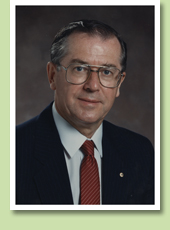
Provenance
1 - Dunn, Peter
1 - Dunn, Peter
|
Home Provenance Series List Gallery |
| Date Range | 2 October 1928 - 4 May 2000 |
| Details Born in 1928, Dunn was raised at Arthur River, a remote settlement in Tasmania which had no running water or electricity. The family later moved and Peter attended Burnie High School before completing a science degree at the University of Tasmania, specialising in organic chemistry and biochemistry. His choice of a career in science may have been influenced by his uncle, Claude Dunn, who suffered lung damage as a result of exposure to phosgene gas during war service on the western front in France. After graduating with honours in 1949, Dunn was recruited by the Australian Defence Scientific Service, and in 1951 he travelled to the UK to undertake research at a British Ministry of Defence laboratory. While in England, he married his Australian fiancé Roma Vallance, with whom he became engaged while studying in Hobart. On the couple’s return to Australia in 1953, Peter Dunn worked primarily for the Commonwealth government’s Defence Standards Laboratories located at Maribyrnong, Victoria (from 1974, known as the Materials Research Laboratories), a connection he maintained until his retirement as Chief of the Protective Chemistry Division in 1993. During this period he undertook a Doctorate of Science by thesis, awarded in 1980.The Dunn family also spent several years in the United States of America (1964-1967), where Peter Dunn was engaged on research for the US Army Natick Research Laboratories. In 1984, Peter Dunn’s life changed dramatically when reports of the use of chemical weapons in the Iran-Iraq war surfaced. Australia was asked by the United Nations to provide a specialist to assist in an independent investigation of the charges. Dunn was selected by the Department of Defence to join the mission to Iran. Within three days of the request being made, he had travelled to meet other members of the team in Frankfurt, Germany; from where, under tight security, they were flown to Tehran. On arrival, the five member UN group was taken to a morgue where they were shown bodies in rudimentary wooden coffins, and to a hospital. It was a ‘devastating experience’ as they observed hundreds of people suffering from suspected mustard gas poisoning and chemical burns. The team then visited the frontline of the conflict. In extreme conditions and without assurances of safe conduct, they risked artillery fire to collect samples from disarmed bombs in the field, to test for chemical agents after doctors expressed concern about patients who displayed classic symptoms of nerve toxins. It was, according to Dunn, ‘a remarkable day’. Peter Dunn revisited the region on subsequent UN missions: to Iran during 1986 and 1987, and Iraq in 1987. The use of chemical warfare in the conflict, however, reached an apex during the first Gulf War (August 1990 - February 1991). In early 1991, after their defeat, Iraq accepted the requirements of Security Resolution 687 which provided the mandate for the United Nations to seek out and destroy weapons of mass destruction in that country. A 24 member team of international specialists was assembled to inspect and assess Iraq’s chemical weapons arsenals, munitions and storage facilities. On the brink of retirement, Peter Dunn was appointed Chief Inspector of the mission. The logistics of the mission were problematic and hazardous. It was Dunn’s responsibility to complete a detailed survey of chemical plants and weaponry, assess the hazards, and assist in planning their destruction. In full protective suits, the UN team visited the massive chemical facility at the Al Muthanna State Establishment. Working for six days in 45 degree heat, they uncovered evidence of an estimated 45,000 chemical weapons. Peter Dunn continued his advocacy for the cause of chemical weapons disarmament as an independent spokesperson and as Australian Commissioner on behalf of the UN up until his diagnosis, in 1997, with malignant mesothelioma, caused by exposure to hazardous materials during the course of his work during the 1960s. He died on 4 May, 2000. The importance of Peter Dunn's work did not go unnoticed in his lifetime. In 1989, in recognition of his early work with the UN, Dunn received the Australain ANZAC Day Peace Prize. Already, in 1985, he had been named a Member of the Order of Australia, an honor that was upgraded to Officer of the Order in 1992. In 1996 he became only the eleventh scientist in eighty years to be inducted as an Honorary fellow of the Royal Australian Chemical Institute, and the following year he was awarded an honorary Doctor of Laws from the University of Tasmania. | |
|
Published by the eScholarship Research Centre, The University of Melbourne,
Listed by Ann McCarthy, Antonina Lewis, Anna Russell, Elizabeth Daniels, and Arlie McCarthy HTML edition Updated 14 July 2014 http://www.esrc.unimelb.edu.au/DUNP001.htm The template for this finding aid is part of the Heritage Documentation Management System |
[ Top of Page | Home | Series | Provenance ] |